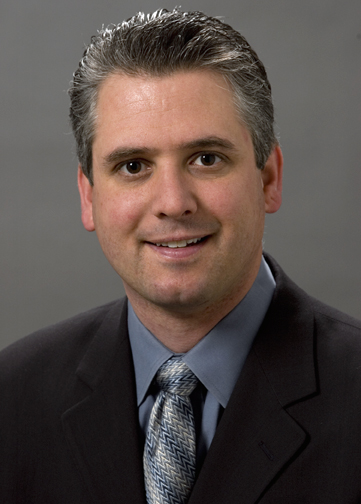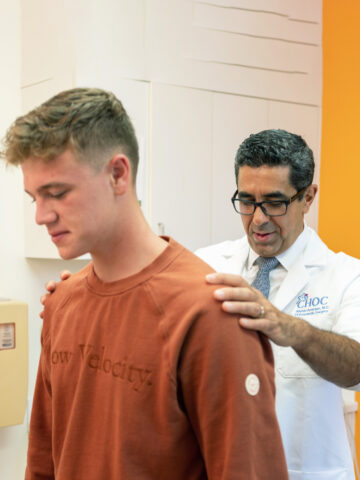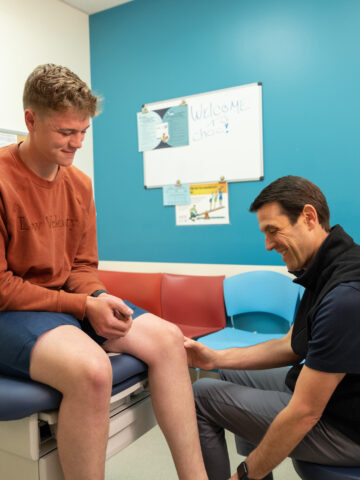In the recent talk, “Diagnosis and prevention of musculoskeletal injuries in sports,” for CHOC Grand Rounds, pediatrician and specialist in sports medicine Dr. Chris Koutures aids providers with useful strategies for understanding and diagnosing sports injury conditions and determining referrals, rehabilitation and prevention for pediatrics.

Dr. Koutures suggests the following approaches for successful diagnoses and treatments for sports injuries in young athletes — enabling them to get back on the field, stronger than ever.
Changes you may wish to make in practice
Dr. Koutures begins his talk with some helpful changes that providers may consider for diagnosing musculoskeletal injuries in their practices. He suggests:
- Focusing on the child when obtaining histories and making treatment plans for sports-related injuries.
- Examining regions proximal and distal to the area of concern.
- Emphasizing what the child can do rather than what they can’t do when determining rehabilitation programs.
Schedule X-rays and further testing effectively
Anticipate Monday calls, says Dr. Koutures, from accidents that happened over the weekend. You may ask yourselves: How do we see all these kids?
If you don’t have an in-office X-ray, bring in the athlete first thing in the morning for an exam. Then, send them off to get an X-ray and bring them back later. An exam will help guide you in making a diagnosis. Contrary to what their parents may want, we do X-rays before MRIs most of the time, says Dr. Koutures.
Focus on the child
Make the patient as comfortable as possible:
- Have pillows available.
- Exams will be easier when they’re wearing shorts or tank tops.
- Have the patients their socks and shoes off.
You move, the patient doesn’t, says Dr. Koutures. Move your table away from the wall and go to them so they don’t have to come to you — especially when they’re in pain.
Additionally, he suggests:
- Speaking directly to the child and have the parent as your secondary informant.
- Having the child describe to them what happened and what they are feeling.
- Seeing the athlete separate from the parent, if necessary.
- Be wary of over-identification from parents for their child’s sports role. For example, my seven-year-old gymnast is different from my seven-year-old that likes gymnastics.
Ask about the patient’s history including past injuries
Dr. Koutures stresses the importance of obtaining a full history of the patient before letting your exam determine treatment.
“As in all medicine, a good history dictates our physical exam,” he says.
Ask the patient, and parents, the following questions about their history:
- Has the child had any previous injuries of any nature?
- Have they changed their technique or position in their sport?
- Has the length of their participation been altered?
- Have they missed any games or practices?
- What type of past rehab, treatment or medication has the child received?
- Any prior pain for the child before the acute injury?
The greatest risk factor for future injury is incomplete rehabilitation of a past injury, he says.
Use an exam to confirm history
Let your physical exam confirm your patient’s history.
During the exam, let the child locate the exact location of their pain. For example, if they wave their hand up and down an area of their body, that’s one level of concern. But if they can point to an exact location with their fingertip, that’s more worrisome.
A large area of immediate swelling especially about the knee of the lateral elbow also will get my attention, says Dr. Koutures.
If the family has a video of the game or performance, be sure to watch it; it’s helpful to see the injury in live time.
With high-level athletes or performers, you may be unfamiliar with the move they were executing when they were injured. Have the parents or siblings demonstrate, if possible. If not, look it up online.
Understand the nature of the child’s participation in sports
Make sure to take notes on the following, says Dr. Koutures:
- Number of sports played, including the length of their participation in the sport.
- Count the hours per day/days per week about the following:
- Practices.
- Rehearsals.
- Games.
- Private lessons.
- Strength training.
- Other units, such as the meters swam, miles run, or pitches thrown per day/per week.
- How many rest days do they have per week? For a lot of athletes, this number may be zero.
If you get an idea of what the athlete is doing, you can counsel them to prevent injuries, says Dr. Koutures.
Keep an eye out for red flags
Red flags to look for when doing the exam and learning about a patient’s history include:
- The child is awakening due to pain.
- The child complains of functional back pain, which is rare in kids.
- There is inflammatory multi-joint pain and swelling.
- If there’s no history of an injury but there’s fever, weight loss, fatigue, rash, or pain without a logical fracture — take in mind the possibility of tumors, infections or systemic illnesses.
Look for signs of overuse
Single-sport specialization versus multi-sport involvement
Kids who will specialize in a sport will focus on just that one and exclude participation in any others. Participation in these sports will often be year-round. If kids specialize in one sport before puberty, it’s called early specialization. Usually, early specialization is done with the intention of developing elite athletes, like gymnasts or figure skaters.
On the contrary, late specialization — or choosing to specialize in a sport after puberty — with early diversification with different sports can help kids develop a foundation of movement patterns and social skills.
Multi-sport participation helps develop the athletes and reduces stressors. However, too much involvement in many sports can also be detrimental. If an athlete is playing multiple sports, especially in the same season, it may be tiring for the child and lead to burnout.
Signs of overuse
Behaviorally, providers should look for the signs of overuse like a child’s decreased desire to practice, sleep/appetite disturbances, withdrawal from social activities, risky behaviors, or family discord you can sense in the room.
During an exam, look out for the following physical cues that may indicate overuse:
- Atypical growth curves: excessive weight loss, drop in BMI or excessive weight gain.
- High pulse: overtraining may lead to a high resting heart rate.
- Low pulse: < 60 bpm is common in well-conditioned athletes, but < 50 bpm can suggest anorexia or low energy intake.
Key points to remember about overuse
- The primary focus of sports for young athletes should be to have fun and learn lifelong physical activity skills
- Participating in multiple sports, at least until puberty, decreases the chances of injuries, stress and burnout in young athletes.
- Early diversification and later specialization provide for a greater chance of lifetime sports involvement, lifetime physical fitness and possibly elite participation.
- Having at least a total of three months off throughout the year, in increments of one month, from sports will allow for athletes’ physical and psychological recovery.
- Young athletes having at least one to two days off per week from their sport of interest can decrease the chance for injuries.
An overuse rule of thumb
According to an enlightening study, the number of hours spent playing sports per week should not exceed their age.
For example, if a child is 14 years old and they are doing more than 14 hours a week of organized sports – their risk for injury increases. In addition, athletes who participate in organized sports compared to free play in a time ratio of >2:1 hours/week are at an increased risk for injury.
This rule of thumb is especially useful for teenagers and can be a quick reference to give to parents, says Dr. Koutures.
Use your resources: When and how to refer patients
Use resources to help build your team! If you need help with the diagnosis or treatment of a sports injury, utilize the specialty of:
- Sports medicine specialists.
- Sports psychologists.
- Registered dieticians.
- Physical therapists.
- Athletic trainers
- Mentors, coaches and teachers.
When and how you should refer your patient to a sports medicine specialist:
- If you feel alone with a difficult decision.
- Time sensitivity.
- More serious injuries.
- Find specialty colleagues who communicate well, appreciate athletic demands, can offer timely appointments, and are aware of current standards.
- Confer with team physicians (with appropriate consent).
- Secure portals for sharing images.
Pearls for sports injury rehabilitation
- Ask the child about their upcoming goals for the next three months. The child may have different goals than their family and they get to run the show when it comes to future priorities.
- Use resources – reach out to certified athletic trainers, physical therapists and coaches/instructors.
- Supervised programs tend to do better than home programs alone.
- Make things fun with rehab “games.”
Cross-train, modify and get creative with rehab
- If the child has an upper-body injury, have them do lower-body work. For lower body injuries, focus on the upper body and central strength like shoulders and hips/gluteals.
- Encourage non-impact exercises, such as yoga and Pilates, swimming and stationary bikes or ellipticals.
- Limit impact – discourage initial running or jumping.
As they get closer to recovery – you can start letting them throw, hit, catch, etc. on a limited basis. Use the following strategies to help:
- Make sure to throw or kick on an “arc” before on a “line.”
- Run shorter distances.
- Swim – initial kick only, then freestyle.
- Mark steps to get timing with dance.
- Have regular communication with coach and team to gradually advance athlete.
It’s a step-by-step process for athletes to get back in the game. First, they may return to stationary sport-specific duties (like shooting and throwing). Then, they can return to practice. Finally, they can return to full competition.
View Dr. Koutures’ full Grand Rounds lecture, “Diagnosis and prevention of musculoskeletal injuries in sports” here.
Refer a patient to the Sports Medicine Program at CHOC’s Orthopaedic Institute.




